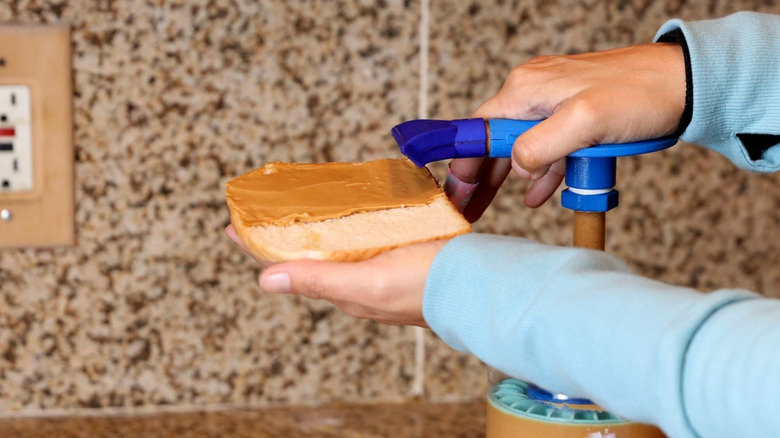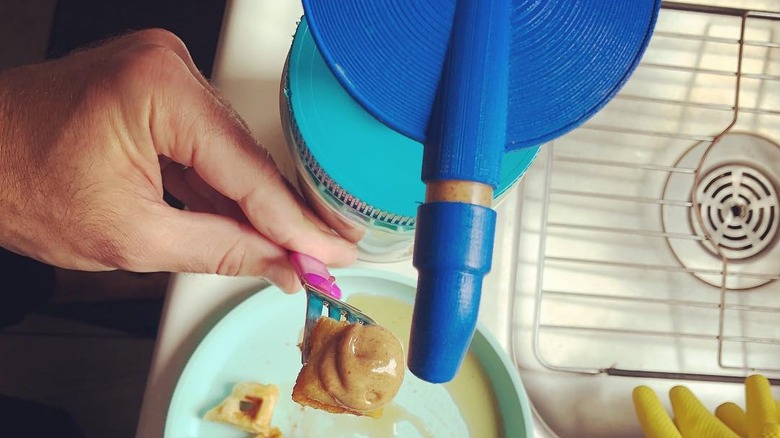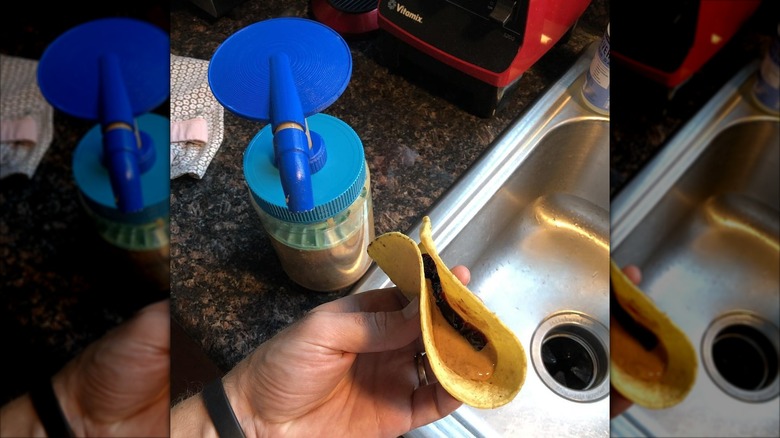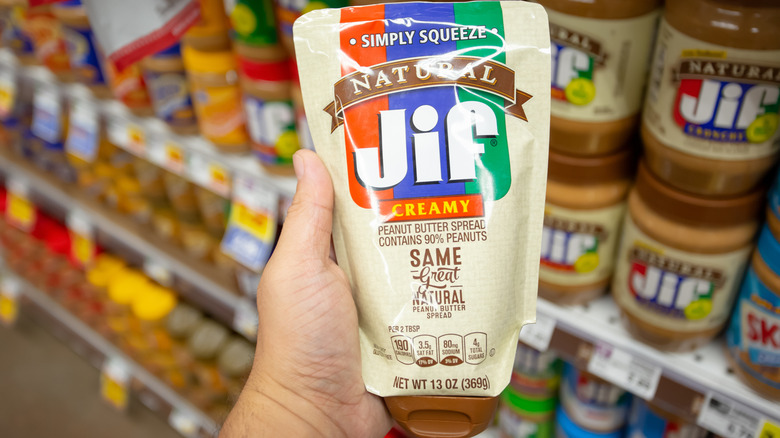Peanut Butter Pump: Here's What Happened After Shark Tank
If you're someone who likes to consume peanut butter on the regular, one inventor's idea makes it simpler to get virtually every drop of the nutty substance out of its jar — no fuss, no muss. Just a quick press of a pump and out it comes in even strokes. Should you eat peanut butter every day? Many people do. If you're one of them, the Peanut Butter Pump could be right up your alley — the perfect hardware to go with other Shark-alum, Nuts 'N More.
The product debuted on season 11, episode 7 of "Shark Tank," and was introduced to the Sharks by inventor Andy Scherer. The device was simple enough in concept. Similar to pumps used for dispensing lotion or soap, the Peanut Butter Pump is affixed to the opening of a peanut butter jar and was engineered to use suction to remove the condiment smoothly and uniformly, cleaning the sides of the container and extracting every bit of nut butter.
Scherer originally crowdfunded his invention on Indiegogo, initially raising over $100,000 from more than 3,000 investors. He then approached the Sharks, hoping to get their backing to help take his idea from prototype to production. He explained that he first explored the idea for his pump after being laid off from a job in finance. "But I didn't get mad. Instead, I got hungry," he told the Sharks (via YouTube). "So, I went home, and I made a sandwich." While Scherer didn't specify what sweet topping he paired with his snack — eating that post-firing peanut butter sammie was the inspiration behind creating the Peanut Butter Pump.
What happened to Peanut Butter Pump on Shark Tank
Present in the Tank were Sharks Mark Cuban, Lori Greiner, Robert Herjavec, Daymond John, and Kevin O'Leary. Andy Scherer asked the panel for $200,000 in exchange for a 15% stake in his company. He then unveiled and demonstrated his product, eliciting literal "oohs" and "ahhs" from the "Shark Tank" stars as he showed how a slice of bread was evenly coated with peanut butter in seconds with just two presses of his pump.
Shark Kevin O'Leary revealed that he is a "peanut butter connoisseur," regularly buying artisan versions of the product, as well as making his own at home. While this initially signaled potential good news for Scherer, O'Leary had various logistical questions about the invention, such as how wide the opening was to accommodate crunchy peanut butter and whether the device could be stored in the refrigerator. Scherer then stated the product only worked with stabilized peanut butter — not artisan products — and that he actively advised people not to store it in the fridge. He then revealed that his invention was just in the prototype stages, with preorders only, and that he had already missed his promised delivery date and had withdrawn some of the investment money.
Ultimately, the Sharks thought the product price of $27 per unit was too high, and they concluded the invention didn't solve a real, existing problem for consumers. O'Leary also thought the pump excluded a large percentage of peanut butter consumers. In the end, all of the Sharks passed on investing. In their opinion, the Peanut Butter Pump wasn't a peanut butter gadget you didn't know you needed — it was a product attempting to solve a nonexistent problem.
Peanut Butter Pump after Shark Tank
In his post-Tank interview, Andy Scherer was optimistic, stating that people loved his product and that it would ultimately succeed and be manufactured. "It's a shame that they didn't go for it," he said, "but somebody will" (per YouTube). However, despite Scherer's upbeat outlook, it was not all smooth sailing for the inventor and his product after "Shark Tank."
In updates on his Indiegogo crowdfunding page immediately following the "Shark Tank" episode's airing, Scherer implied that editing of the show had mistakenly given the impression that all of the crowdfunding money was gone, suggesting that some investors had been concerned and were vocal about it. "There are sufficient funds to ensure that all orders are fulfilled. The edits may have left other impressions, and I want to clear that up," he wrote (via Indiegogo). He also reassured backers about continued forward motion, reiterating something he had mentioned on the show, which was that he would sell his house, if necessary, to ensure the product was a success. "If I have to choose between keeping my word or keeping my house, it's an easy choice: sell the house, keep the promise," he stated in the update.
Scherer asserted that his preordered products were slated to ship in January 2020. However, neither his optimism nor his projected timeline ultimately panned out, and it's been a bumpy (chunky might be a better word) ride for the inventor and his Peanut Butter Pump ever since. From switching manufacturers to continuous production delays, unfulfilled manufacturer promises, and outright errors from the China-based factory he contracted with, months stretched into years without his invention ever going into production or orders being fulfilled.
Is Peanut Butter Pump still in business?
Years of setbacks and manufacturing failures ultimately led to the demise of the Peanut Butter Pump — as initially conceived, anyway. In 2023, Andy Scherer announced that his original design had been completely abandoned. In its place, a totally new product was being pursued. Instead of a topper for existing jars of peanut butter, the much bulkier and more expensive new device would pump the condiment from prefilled pouches enclosed inside, squeezing the ingredients out of them. Replacement pouches of peanut butter would have to be ordered directly from the company.
Feedback from investors over this bombshell included accusations of deception and being strung along for years, as well as pointing out that the attraction of the original Peanut Butter Pump was its usability with one's preferred peanut butter brand. The new concept locked people into using predetermined products rather than the ones they liked. To remedy the latter complaint, Scherer announced he would include a refillable, washable pouch with every device, so users could put their favorite brand of peanut butter into it.
This, of course, leads full circle to the problem Scherer's invention set out to remedy in the first place: the difficulties of getting all of the peanut butter from a jar. It seems, logically, that to use the newly revamped Peanut Butter Pump, one needs the original Peanut Butter Pump concept in order to transfer all of the peanut butter from a jar into the pouch. Scherer suggested the option of using hot water and steam and essentially melting one's jar of peanut butter, so it could be poured in.
What's next for Peanut Butter Pump?
Andy Scherer defended his new pouch concept to investors, saying he believed the peanut butter landscape in general was headed for change. Products like baby food and granola, previously sold in jars and boxes, are now sold in pouches, which are cheaper to make and can be shipped in greater quantities due to their compactness. He said he believed peanut butter was among the next food items to go the way of the pouch, and his revamped product would be positioned to capitalize.
The Jif brand, for instance, now offers its products in squeezable packaging – though Scherer pointed out that these have the same flaws as toothpaste and other squeezables, which is extracting the contents becomes more difficult with each successive squeeze. But he felt this move by a major brand heralded a future in which more peanut butter would be pouch-packaged, and his redesigned Peanut Butter Pump would be the perfect extraction appliance.
The new product, however, has been fraught with setbacks like its predecessor. More broken factory promises and some outright deception from the Chinese manufacturer prompted Scherer to begin shopping for a new fabricator, and factory demands for more money — though previously paid-for work was unfulfilled — also sent the inventor looking for new investors. Meanwhile, some original backers started asking for refunds. Scherer responded that he couldn't provide refunds to those wishing to pull out, but with future financing that could change.
As of December 2023, after many delays, Scherer finally had a functional prototype of his new design, which he was preparing to demonstrate to potential investors. He was still working with the same problematic Chinese manufacturer though he had formed contacts with some alternatives. Time will only tell if the product fully materializes, but Scherer remains steadfast in his commitment.





